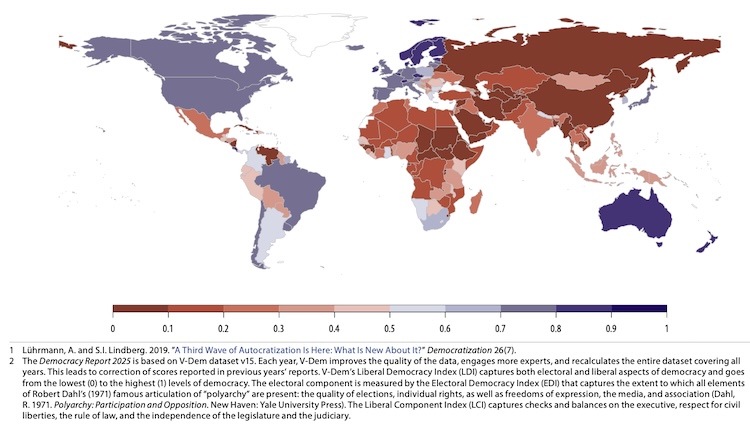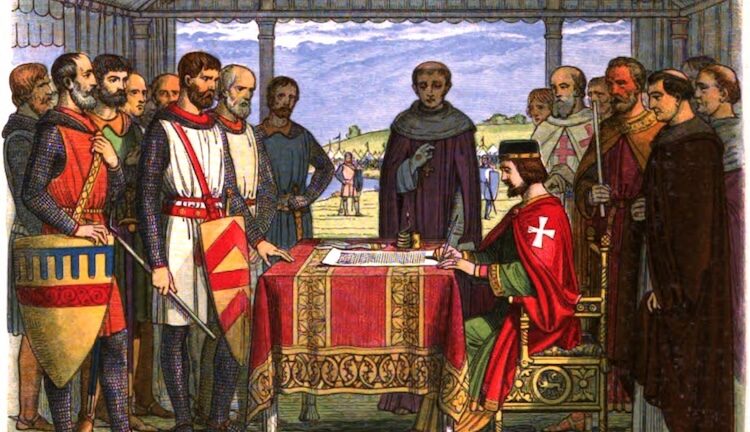By Ramesh Jaura
This report was published on https://rjaura.substack.com
BERLIN | 19 June 2025 (IDN) — The V-Dem Institute reports that the global outlook at the end of 2024 is less favourable compared to the past 25 years. The trend known as the “third wave of autocratization” is intensifying and expanding.
This phenomenon is affecting regions worldwide, with Eastern Europe and South and Central Asia experiencing significant declines. North America and Western Europe are also being impacted. Currently, there are 88 democracies (liberal and electoral) and 91 autocracies (electoral and closed), marking a change from the previous year. According to the Institute, which is based in Gothenburg, Sweden, nearly 72 per cent of the world’s population now lives in autocratic states.
At this pivotal moment, in June 2025, a remarkable milestone has quietly passed: 810 years since the sealing of the Magna Carta, a document whose legacy continues to resonate through courtrooms, parliaments, and human rights campaigns worldwide. Though written in Latin in 1215 by feuding English barons and a beleaguered king, the Magna Carta—or “Great Charter”—is anything but a forgotten relic. It is, in fact, one of the most influential legal documents in history.
What did the Magna Carta achieve, why was it written, and why is it still relevant today? To grasp its importance, we need to revisit medieval England, see how the document evolved, and consider its significance in today’s context of digital surveillance, rising authoritarianism, and demands for accountability.
A Medieval Crisis of Power
The Magna Carta originated during a period of significant political turmoil. King John of England, who reigned from 1199 to 1216, faced widespread unpopularity among his subjects. His military failures, notably the loss of English territories in France, had severely depleted the royal treasury. In an attempt to replenish it, he imposed substantial taxes and fines on the nobility. The discontent was not limited to the barons; the general populace also endured hardships under his arbitrary governance, which included imprisonment of opponents without trial and confiscation of property without justification.
In 1215, a group of barons, dissatisfied with King John’s heavy taxation and authoritarian governance, took decisive action by seizing London. This forced the king into negotiations, resulting in the Magna Carta, which was formally sealed on June 15, 1215, at Runnymede, a meadow west of London. Although originally intended as a temporary peace agreement, the Magna Carta has since been recognized as a pivotal document in the evolution of legal and constitutional principles.
What the Magna Carta Said
The original Magna Carta comprised 63 clauses addressing various feudal issues. Many of these clauses pertained to baronial rights and feudal dues. However, certain clauses were notable for articulating broad principles of justice.
Two of the most quoted clauses are:
- Clause 39: “No free man shall be seized or imprisoned, or stripped of his rights or possessions… except by the lawful judgment of his equals or by the law of the land.”
- Clause 40: “To no one will we sell, to no one deny or delay right or justice.”
These principles laid the foundation for what we now refer to as due process and the rule of law. While the document initially applied only to “free men”—excluding serfs, women, and many commoners—the ideas eventually expanded far beyond their original scope.
From Failed Treaty to Living Document
The Magna Carta didn’t have an easy start. Within weeks of sealing it, King John had the charter annulled by Pope Innocent III, sparking the First Barons’ War. John died the following year, and his son Henry III reissued a revised version in 1216, 1217, and again in 1225. This final version became the legal standard for centuries to come.
Over time, the Magna Carta’s practical clauses became obsolete, but its symbolic power only grew. In the 17th century, English judge Sir Edward Coke invoked the Magna Carta in resisting the authoritarian rule of King Charles I. He claimed that the king was not above the law—an argument that helped ignite the English Civil War.
Centuries later, in colonial America, revolutionaries cited the Magna Carta in their protests against British tyranny. Its influence can be found in the U.S. Constitution and Bill of Rights. Across the world, former colonies looked to it as a model for limiting government power and asserting legal protections.
A Global Symbol of Justice
Today, the Magna Carta is held up as a foundational document for liberal democracy and constitutional governance. Although only three of its original clauses remain in British law, its legacy can be felt everywhere. The idea that no one—not even a monarch or head of state—is above the law is central to modern legal systems.
Legal protections, such as habeas corpus (the right to challenge unlawful detention) and trial by jury, trace their roots back to the Magna Carta. International human rights documents, such as the Universal Declaration of Human Rights and the European Convention on Human Rights, echo its principles.
Original copies of the charter are preserved with great care. Two are housed in the British Library, while others can be found in Lincoln and Salisbury Cathedrals. Each year, scholars and tourists alike visit these sites, drawn by the document’s enduring mystique.

Why It Still Matters in 2025
In an era marked by increasing authoritarianism, political polarisation, and the proliferation of surveillance technology, the Magna Carta remains profoundly relevant. Its message—that the power of rulers must be limited by law—resonates in the fight for civil liberties around the globe.
Around the world, activists invoke the Magna Carta to challenge injustice. In Hong Kong, pro-democracy protesters referenced it during their demonstrations. In the U.S., legal scholars continue to cite it in Supreme Court opinions. In countries where governments overreach, the Magna Carta stands as a historical example of how people can push back.
Its lessons extend to the digital world as well. As governments and corporations gain unprecedented access to personal data, the need for legal boundaries and protections is more important than ever. Magna Carta reminds us that liberty depends on law, and law must be fair, transparent, and accessible.
Debates and Misuses
Despite its fame, not everyone sees Magna Carta as a democratic icon. Some historians argue that it was never meant to protect ordinary people, and its modern reputation is the result of centuries of reinterpretation. Others warn that invoking the charter too loosely can lead to confusion.
In recent years, conspiracy theorists and self-styled “sovereign citizens” have cited the Magna Carta in court to claim immunity from taxes or laws. Legal experts caution that such uses distort the document’s actual intent and meaning.
Still, these misinterpretations don’t diminish its legitimate influence. Instead, they underscore the need for public understanding of legal history—and for clear communication about the values we attach to iconic texts.
Commemorating a Living Legacy
As the Magna Carta marks its 810th anniversary, its influence remains profound and relevant. In educational settings, judicial systems, and legislative bodies, it continues to inspire discussions about liberty, authority, and the rule of law. Institutions like the British Library organize exhibitions and lectures to delve into its significance. Additionally, documentaries and educational campaigns persist in introducing its history to new generations.
The Magna Carta reminds us that progress often begins with resistance to unchecked power. While the specifics of 13th-century feudalism may seem distant, the core idea—that law should be a shield against tyranny—is timeless.
In 2025, we may no longer speak in the language of barons and kings, but the struggle for justice, fairness, and accountability endures. The Magna Carta stands as a powerful symbol of that struggle, reminding us that the fight for liberty is never truly over. [IDN-InDdepthNews]
Original link: https://rjaura.substack.com/p/the-enduring-influence-of-a-medieval
Image: A romanticised 19th-century recreation of King John signing Magna Carta. Rather than signing in writing, the document would have been authenticated with the Great Seal and applied by officials rather than John himself. Wikimedia.


